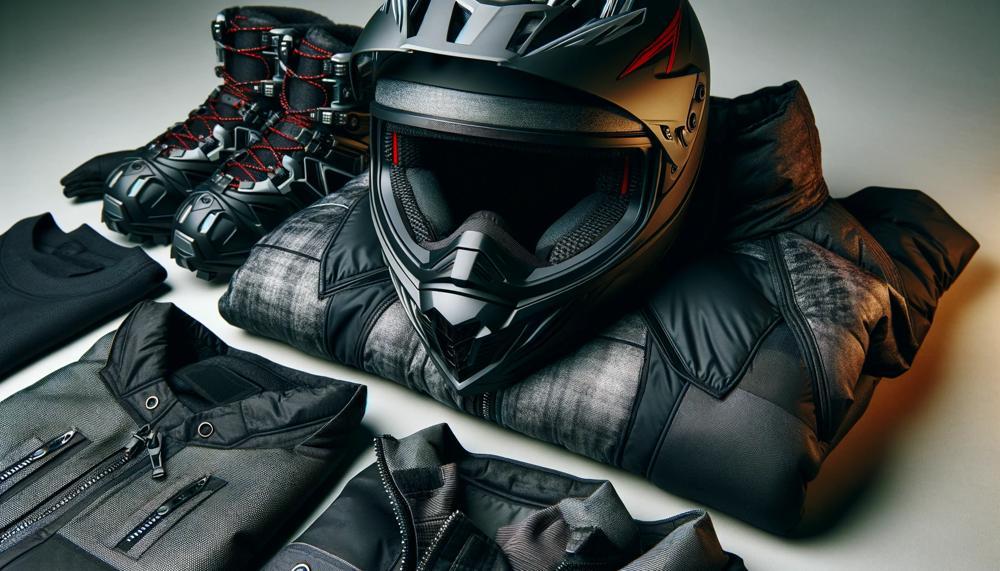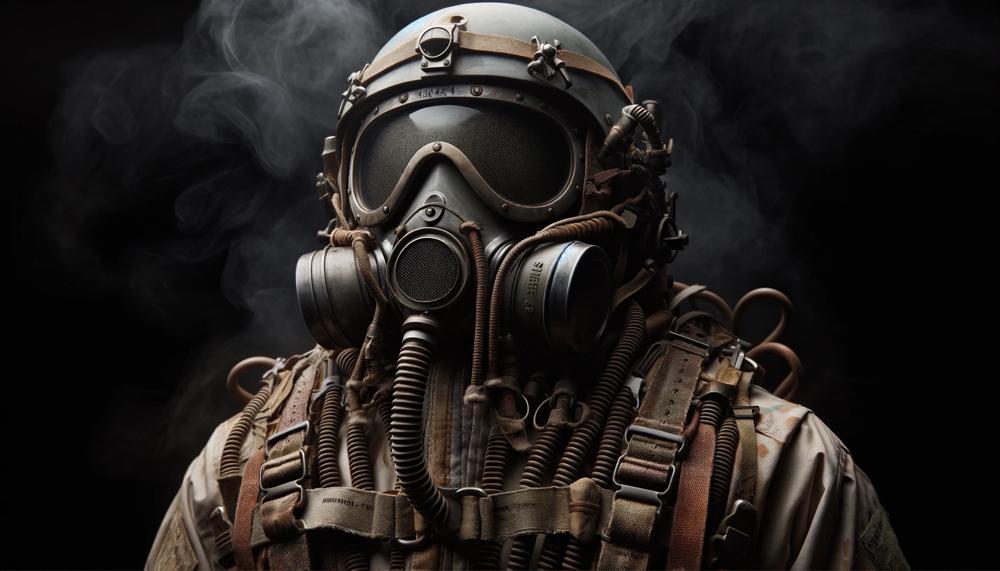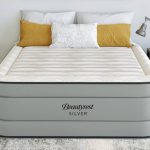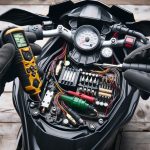Are you ready to embark on a thrilling adventure through snowy trails on your trusty snowmobile? Before you hit the throttle, it’s crucial to ensure that you have all the necessary gear, including proper attire to wear under your helmet.
While it may seem like a minor aspect, selecting the right layers can greatly impact your comfort and safety while riding.
So, What Should You Wear Under Your Snowmobile Helmet?
Here are some things you can wear under a snowmobile helmet:
- Balaclava: A balaclava covers your head except for your mouth and eyes. It can keep sweat out of your helmet in the summer and keep you warm in the winter. Balaclavas made of silk and thin polyester are more comfortable and lightweight than other fabrics.
- Face mask: A face mask is essential to avoid frostbite, especially on cold days. A thin fleece balaclava and a NoFog neoprene mask can keep you warm and fog-free.
- Base layer: A base layer should be made of polyester or synthetic. It should regulate body temperature and wick moisture away from the skin. You can wear a long underwear top and bottom or an “onsie”.
- Socks: Wear a thin, moisture-wicking sock and add a thicker wool or synthetic sock over top.
- Snowmobile boots: Wear dedicated snowmobile boots to keep your feet warm. They have thick insulation and a waterproof exterior.
You can also use a three-layer technique to dress warm for snowmobiling. This technique starts with a thin base layer, then an outer shell to block the wind and provide insulation, and finally an outer shell to block the wind and provide insulation.
Now that you’re familiar with the basics, let’s delve deeper into the specifics of choosing the ideal clothing for under your snowmobile helmet.
What Snowmobile Outfits Should You Be Purchasing
Contents
- 1 What Snowmobile Outfits Should You Be Purchasing
- 2 Avoid Cotton Fabrics When Snowmobiling
- 3 Dress in Layers on a Snowmobile
- 4 Wear a Snowmobile Suit
- 5 Wear Warm Snowmobiling Gloves That Grip
- 6 Don’t Forget a Mask or Balaclava
- 7 Wear Warm Socks and Waterproof Boots
- 8 Protective Goggles and a Safety Helmet Are a Must When Snowmobiling
- 9 Hand Warmers for That Extra Comfort
- 10 What To Wear When Snowmobiling: It’s Complicated
- 11 Conclusion
When it comes to hitting the slopes on a snowmobile, having the right gear is crucial for both safety and comfort.
A snowmobile outfit should include a jacket, pants, gloves, boots, helmet, goggles, layers of clothing, and socks. These items can be purchased at outdoor sports stores or online retailers.
| Item | Description | Purchase Options |
| Jacket | Stay warm and dry with a waterproof jacket equipped with a hood. Choose from insulated or shell options for ultimate protection. | Outdoor sports stores or online retailers. |
| Pants | Keep your legs protected with waterproof and durable pants. Choose between regular pants or bibs for added coverage. | Outdoor sports stores or online retailers. |
| Gloves | Don’t let cold hands ruin your ride. Invest in a pair of gloves that come in various sizes and styles to keep your hands warm. | Outdoor sports stores or online retailers. |
| Boots | Ensure a good grip on your snowmobile’s rails with heavy-duty and waterproof boots. Don’t skimp on quality when it comes to keeping your feet dry. | Outdoor sports stores or online retailers. |
| Helmet | Safety first. A helmet is critical for protecting your head while riding. Choose from full face or open face options for maximum comfort. | Outdoor sports stores or online retailers. |
| Goggles | Squinting in the sun or battling glare from snow is no fun. Protect your eyes with goggles that shield them from UV rays and variable light conditions. | Outdoor sports stores or online retailers. |
| Layers of clothing | Stay warm and cozy with layers of clothing. Choose from synthetic materials or natural fibers for your base layer, and add mid-layers like sweaters or light jackets for extra warmth in cold weather. | Outdoor sports stores or online retailers. |
| Socks | Don’t forget about your feet. Invest in socks made of materials like merino wool to keep your toes toasty and dry. | Outdoor sports stores or online retailers. |
In addition to these essential items, optional gear such as body armor, backpacks, and snowsuits can also be purchased at these locations. The key is to ensure that all gear is waterproof and suitable for cold weather conditions.
Avoid Cotton Fabrics When Snowmobiling
The first thing that may spring to mind for someone thinking about snowmobiling is an exciting and engaging pastime. But being a specialist in this area, I can assure you that enjoying yourself on the trails safely and comfortably is just as important as the thrill.
When getting ready for a snowmobile ride, a lot of individuals forget to pack their gear. more precisely, the kind of cloth that makes up their equipment. Cotton textiles are popular because they are inexpensive and comfortable. But cotton is not a good choice in cold and damp weather.
Cotton’s primary drawback is its tendency to absorb moisture, which makes you feel uncomfortable and chilly. This may make snowmobiling in below-freezing weather riskier since it raises the possibility of frostbite and hypothermia. Moreover, cotton is a poor option for snowmobiling since it loses insulation quickly when wet.
Purchasing clothing and equipment made of appropriate materials, such wool or synthetic textiles, is crucial to guaranteeing your comfort and safety on the trails. Even in the most severe weather, these fabrics will keep you warmer and drier. Furthermore, materials like down or fleece provide insulation even in rainy conditions. Selecting breathable and waterproof fabrics is also essential if you want to stay dry and warm for long periods of time.
Dress in Layers on a Snowmobile
Dressing in layers while snowmobiling has numerous advantages, including increased comfort, safety, and performance. By layering your clothing, you can easily adjust to changing weather conditions and activity levels.
This also has an impact on what you wear under your helmet, as appropriate layers can provide added cushioning and warmth without limiting mobility.
- Comfort: One of the main benefits of wearing layers while snowmobiling is the ability to adjust your clothing based on the changing weather conditions and your level of activity. This allows for better regulation of your body temperature, keeping you comfortable throughout your ride. Additionally, layering helps to evenly distribute the weight of your clothing, reducing strain on your neck and shoulders when wearing a helmet.
- Safety: Layering is crucial for snowmobiling as it provides insulation and protection against the cold, wind, and snow. It also gives you the flexibility to add or remove layers as needed, depending on the weather conditions. This can help prevent hypothermia and other cold-related injuries.
- Performance: When you are warm and comfortable, you are less likely to experience fatigue, allowing you to ride longer without feeling drained. Layering also impacts what you wear under your helmet, as appropriate layers can provide added cushioning and warmth without limiting mobility. This can improve your reaction time and decision-making abilities while on the trail.
- What to Wear Under Your Helmet: Layering is equally important when it comes to what you wear under your helmet. A thicker base layer can provide extra cushioning for your head and reduce pressure points from the helmet straps. It is crucial to choose appropriate materials for the layers under your helmet – thin, lightweight materials that provide warmth without adding bulk are ideal.
So, dressing in layers while snowmobiling has numerous benefits, including increased comfort, safety, and performance. It also impacts what you wear under your helmet by providing added cushioning and warmth without limiting mobility.
Wear a Snowmobile Suit
It is crucial to wear a snowmobile suit for optimal comfort and safety while snowmobiling. However, when it comes to wearing a suit under a helmet, there are important factors to consider for the best experience.
Waterproof Outer Layers
The outer layer of your snowmobile suit must be waterproof to shield you from the elements. This not only keeps you dry and warm but also prevents moisture from seeping into your inner layers, which can lead to discomfort and even hypothermia in harsh conditions.
Popular choices for waterproof outer layers include Gore-tex and other synthetic blends.
Well-Insulated Underlayers
Underneath your waterproof outer layer, it is recommended to wear well-insulated underlayers.
These layers provide added warmth and cushioning while still allowing for mobility. Acrylic is a common material used for insulation in snowmobile suits.
Helmet
When selecting a helmet to wear over your snowmobile suit, ensure it fits snugly and securely without being overly tight. It should also have proper ventilation to prevent fogging and overheating.
Eye Protection
Snowmobiling can be dangerous for your eyes as they are exposed to cold winds and potential debris on the trails.
It is essential to wear goggles or a face shield over your helmet for maximum protection.
Boots
Wearing suitable boots is critical for both comfort and safety while snowmobiling. They should have good insulation and proper tread for traction on slippery surfaces.
Safety Equipment
In addition to your snowmobile suit and helmet, it is important to wear other safety equipment such as gloves, knee pads, and elbow pads. These will protect you in case of any accidents or falls while riding.
To sum up, the most suitable type of snowmobile suit to wear under a helmet for maximum comfort and safety would consist of waterproof outer layers, well-insulated underlayers, a properly fitting helmet, eye protection, appropriate boots, and other necessary safety equipment.
Wear Warm Snowmobiling Gloves That Grip
For a safe and fun sledding experience, you need to make sure you have the right gear. And warm snowmobile gloves with a good grip are one of the most important things you can buy. Not only do they keep your hands warm and dry, but they also give you better control over your sled, which makes the ride more pleasant.
Why are these gloves so important, though? First, let’s do the obvious thing: keep your hands warm. Anyone who rides a sled knows how hard it can be on your hands when it’s cold outside. But if you wear the right gloves, you can keep them warm and cozy during the ride, so you can focus on how exciting and thrilling the trip is going to be.
But keeping your hands warm isn’t the only reason to wear snowmobile gloves. You can also hold on to them well for better control. This is very important when going over rough ground or making sharp turns. If you have a good grip, you can stay in charge of your sled and easily avoid any surprises.
Also, don’t forget about comfort in general. If you want to enjoy your time on the hills, you need to be able to ride in safety. And having warm gloves that are easy to hold on to can make riding a lot more comfortable, letting you enjoy the beauty and excitement of the winter scenery to the fullest.
Don’t Forget a Mask or Balaclava
Ensuring the safety and comfort of your face and neck while snowmobiling is no laughing matter. That’s why wearing a mask or balaclava under your snowmobile helmet is crucial. Not only does it protect you from the harsh weather conditions, debris, and sun exposure, but it also improves the overall fit of your helmet.
But don’t just pick up any mask or balaclava. For optimal protection, it’s important to invest in a high-quality one specifically designed for snowmobiling. This ensures that it can withstand the elements and provide you with maximum comfort.
Don’t underestimate the importance of a mask or balaclava in your snowmobiling gear. It not only adds an extra layer of protection, but it also enhances your riding experience. Plus, with the wide range of options available, you can find one that suits your style and preferences.
Wear Warm Socks and Waterproof Boots
Snowmobiling is a beloved winter pastime that requires specialized equipment to ensure comfort and safety. One crucial aspect to consider is footwear, specifically boots and socks. When choosing the perfect pair for your snowmobiling adventures, here are some key features to keep in mind.
- Waterproofing: While snowmobiling, your feet are exposed to frigid temperatures, wet snow, and melting ice. Thus, it is vital to select boots that are waterproof to keep your feet dry and warm throughout your ride. Look for boots with a waterproof outer layer and sealed seams to prevent any water from seeping in.
- Insulation: In cold weather conditions, keeping your feet warm is essential. Insulated boots are designed to trap heat and maintain warmth while you ride. Look for boots with high-performance insulation materials like Thinsulate.
- Traction: Navigating through varying terrains, including icy and slippery areas, is part of the snowmobiling experience. Make sure your boots have excellent traction and grip to prevent slipping or sliding while you ride.
- Comfort: You’ll be wearing your boots for extended periods while snowmobiling, so comfort is crucial. Look for boots with cushioned insoles, padded collars, and soft linings for added comfort.
- Durability: Snowmobiling can be harsh on footwear, so it’s essential to choose boots made from sturdy materials that can withstand the elements and rough terrain.
- Material: Wool and synthetic materials are popular choices for snowmobiling socks. Wool provides warmth and moisture-wicking properties, while synthetic socks are lightweight and breathable.
- Thickness: Thick socks provide added warmth, but make sure they’re not too thick as this can cause discomfort while wearing boots.
- Length: Opt for socks that come up high enough to prevent any gaps between your pants and boots, which can let in cold air or snow.
- Cushioning: Seek out socks with cushioned soles to provide extra comfort and support while riding.
- Compression: Some socks offer compression benefits that can improve blood flow and reduce fatigue during long rides.
Protective Goggles and a Safety Helmet Are a Must When Snowmobiling
Protective Eyewear and a Helmet are a Must-Have for Safe Snowmobiling. This combination of gear is crucial for ensuring the safety and well-being of anyone who engages in this thrilling winter activity.
Let’s take a closer look at why wearing protective eyewear and a helmet is essential when snowmobiling.
Protection Against Impact Injuries
Snowmobiling involves navigating through uneven and unpredictable terrain, which can lead to accidents and falls. Wearing a helmet can protect your head from serious injuries during such incidents.
It can absorb the impact of a fall or collision, reducing the risk of concussions, fractures, or other head injuries.
Protection From Environmental Hazards
In addition to impact injuries, there are other environmental hazards that you may encounter while snowmobiling. These include wind, snow, sunlight, and debris from other riders. Protective eyewear provides a barrier against these elements, keeping your eyes safe and allowing you to focus on riding without any distractions.

UV Protection
While it may not seem like it, snow is highly reflective and can amplify the sun’s UV rays.
This increases the risk of eye damage and even snow blindness if you don’t wear protective eyewear. High-quality goggles have a UV coating that blocks these harmful rays and protects your eyes.
Comfort and Visibility
Snowmobiling involves being exposed to harsh weather conditions for extended periods. Wearing protective eyewear ensures that your eyes are shielded from strong winds and snow, preventing any discomfort or irritation.
Additionally, goggles with anti-fog and anti-scratch coatings provide clear visibility in varying weather conditions, making it easier to navigate through the snow.
Recommended Gear by Experts
Experts recommend wearing both a helmet and protective eyewear while snowmobiling for maximum protection against potential hazards.
These pieces of gear are specifically designed to withstand the demands of this activity and are thoroughly tested for safety and durability.
Hand Warmers for That Extra Comfort
Staying warm while riding a sled is very important for a comfy and fun experience. Hand warmers work well to keep hands warm while riding, along with wearing layers and the right clothing. Chemical hand warmers and hot gloves that run on batteries are the two main types of hand heaters.
Battery-powered electrically heated gloves keep your hands warm the whole ride. Most of the time, they have heat levels that can be changed, and they are made to be waterproof and windproof to protect you from the weather. Some models even have fingers that can work with touchscreens, so riders can use their phones without taking off their helmets.
On the other hand, chemical hand warmers come in small packets that have iron powder, water, salt, and activated charcoal mixed together. When these ingredients come into contact with air, they start a chemical process that gives off heat for several hours. They’re handy, cheap, and simple to use—just open the package and shake it to make them work. A lot of snowmobilers like to use chemical hand warmers as a backup or for shorter rides.
There are also chemical hand warmers that can be used more than once. These can be charged again by boiling them in water or heating them in the microwave. These are better for the environment than flammable hand heaters that you throw away after one use.
There are several reasons to use hand heaters while riding. For starters, it keeps your hands flexible, which lets you keep a strong grip on the handlebars and easily use the controls. This might make the roads safer. Hand warmers also keep your hands warm and avoid freezing, so you won’t have to worry about being uncomfortable or distracted while riding.
What To Wear When Snowmobiling: It’s Complicated
When getting ready for an exhilarating snowmobiling excursion, it’s essential to carefully select the appropriate gear to wear under your helmet. Here are the key elements to keep in mind:
| Insulation | Ensure your garments provide sufficient warmth to shield you from the frigid temperatures. |
| Waterproofing | Your gear should be resistant to water to keep you dry in case of snow or rain. |
| Wind protection | Don’t forget about windproofing to safeguard yourself from chilly gusts while riding at high speeds. |
| Mobility and flexibility | Choose attire that allows for effortless movement and flexibility while riding. |
| Visibility | Dress in bright colors or reflective gear to enhance visibility in snowy conditions. |
| Protection | Invest in a high-quality helmet with facial protection, along with gloves and goggles for added safety. |
| Style | Add a touch of flair to your gear for a comfortable and fashionable ride. |
In addition to these factors, it’s crucial to consider wearing thermal socks, suitable footwear, and heated outerwear or accessories for added comfort during long rides. Hand warmers can also be placed inside gloves or pockets for continuous warmth. Remember, appropriate gear not only keeps you comfortable but also ensures safety while snowmobiling.
It is also recommended to invest in eye protection such as snowmobile goggles, sunglasses, or visors to prevent dryness and watery eyes caused by harsh winds. Face masks can also protect against frostbite on cold days, with balaclava face masks made of silk or thin polyester being comfortable and lightweight options. Liners, such as beanies, can add extra warmth and protection under a fully-faced helmet.
Conclusion
Finally, wearing the right clothes under your snowmobile helmet is important for a safe and fun ride. Do not choose any clothes; it is important to layer with fabrics that wick away sweat and stay away from cotton. Also, remember to keep your face and neck safe from the cold winter weather. It is important to buy a full snowmobile outfit from a reputable outdoor sports store or online provider. This should include a waterproof jacket, pants, gloves, boots, a helmet, goggles, layers of clothing, and socks.
Avoid cotton materials because they can soak up sweat and make you feel cold and uncomfortable. Instead, choose wool or synthetic materials that are better for you because they keep you warmer and safer. Layering your clothes not only keeps you warm, but it also makes you more flexible and comfortable while you ride. Also, it’s easy to take off a layer to cool off if you get too hot during the ride.
You should not forget how important it is to have a snowmobile suit with warm, waterproof layers underneath. This will make sure that you are as comfortable as possible under your helmet, even when it’s very cold outside. Don’t forget to bring warm gloves that are easy to hold on to and a mask or hood to keep your face from getting windburn.
Finally, make sure you wear warm socks and boots that are waterproof and have good grip so that your feet stay dry and comfortable during the ride. After all, a rider with happy feet is a happy rider. Before you go on your next snowy trip on your trusty sled, make sure you have everything you need, including the right clothes to wear under your helmet, for an amazing experience.






